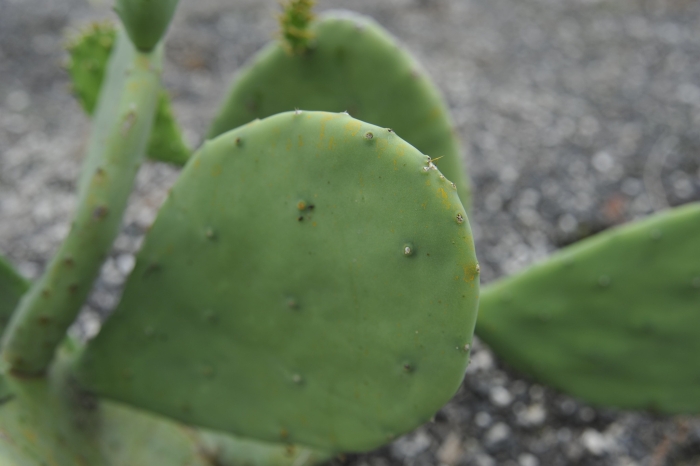Spineless Prickly Pear
(Opuntia ellisiana)
Spineless Prickly Pear (Opuntia ellisiana)
/
/

Megan Hansen
CC BY-SA 2.0
Image By:
Megan Hansen
Recorded By:
Copyright:
CC BY-SA 2.0
Copyright Notice:
Photo by: Megan Hansen | License Type: CC BY-SA 2.0 | License URL: https://creativecommons.org/licenses/by/2.0/ | Uploader: MeganEHansen | Publisher: Flickr |









Estimated Native Range
Summary
Opuntia ellisiana, commonly known as Spineless Prickly Pear, is an evergreen succulent native to semi-arid grasslands and desert regions in the Southwestern United States and Northwest Mexico. It typically grows to a height of 1-2 feet (0.3-0.6 meters) and a width of 0.5-1 feet (0.2-0.3 meters). This plant is characterized by its flat, fleshy, oval to round pads that are blue-green in color and lack the long, sharp spines typically associated with cacti, although they may have small, barbed bristles called glochids. Spineless Prickly Pear blooms in the summer, producing cup-shaped yellow flowers that are followed by purple-red fruits, which are edible and attract wildlife.
Spineless Prickly Pear is valued for its drought tolerance and low maintenance requirements, making it an excellent choice for xeriscaping and rock gardens. It is also used as an ornamental plant in containers or as a ground cover in arid climate landscapes. Its ability to propagate easily from pads allows for simple vegetative reproduction. In cultivation, it thrives in full sun and requires very little water, preferring well-draining soils. While generally disease-resistant, it can be susceptible to root rot if overwatered. It is important to handle this plant with care due to the presence of glochids, which can easily detach and irritate the skin.CC BY-SA 4.0
Spineless Prickly Pear is valued for its drought tolerance and low maintenance requirements, making it an excellent choice for xeriscaping and rock gardens. It is also used as an ornamental plant in containers or as a ground cover in arid climate landscapes. Its ability to propagate easily from pads allows for simple vegetative reproduction. In cultivation, it thrives in full sun and requires very little water, preferring well-draining soils. While generally disease-resistant, it can be susceptible to root rot if overwatered. It is important to handle this plant with care due to the presence of glochids, which can easily detach and irritate the skin.CC BY-SA 4.0
Plant Description
- Plant Type: Succulent
- Height: 1-2 feet
- Width: 0.5-1 feet
- Growth Rate: Moderate
- Flower Color: Yellow
- Flowering Season: Summer
- Leaf Retention: Evergreen
Growth Requirements
- Sun: Full Sun
- Water: Very Low, Low
- Drainage: Fast
Common Uses
Bee Garden, Bird Garden, Butterfly Garden, Deer Resistant, Drought Tolerant, Edible*Disclaimer: Easyscape's listed plant edibility is for informational use. Always verify the safety and proper identification of any plant before consumption., Fire Resistant, Groundcover, Hummingbird Garden, Low Maintenance, Rock Garden, Showy Flowers, Street Planting
Natural Habitat
Semi-arid grasslands and desert regions
Other Names
Common Names: Tigertongue
Scientific Names: , Opuntia ellisiana, Opuntia lindheimeri var. ellisiana,
GBIF Accepted Name: Opuntia ellisiana Griffiths